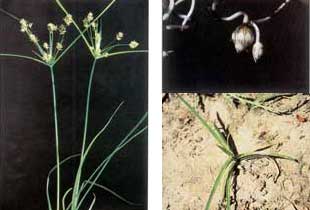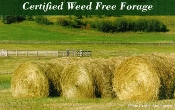Yellow nutsedge
Cyperus esculentus L.
Keys to Identification
- Yellow nutsedge can be identified by its stout triangular stem
- 3-ranked, grass-like leaves
- Yellow nutsedge also has dark, unevenly globe-shape, almond tasting tubers at the ends of slender rhizomes
This information courtesy of the Colorado Natural Areas Program
Family
Sedge (Cyperaceae)
Other Names
Chufa, chufa flatsedge, nut-grass, galingale.
USDA Code
CYES
Legal Status
Colorado Noxious Weed List B
Identification
Lifecycle
Perennial
Growth form
Grass-like
Flower
Flowers are yellowish-brown. The entire cluster of flat spikelets have by 3-9 leaflike bracts below.
Seeds/Fruit
Seeds are yellowish, triangular, and oblong.
Leaves
Grass-like leaves originate from the base of each stem, while long leaf-like bracts radiate out from a common point just below the umbrella-like flower cluster.
Stems
Plants range from 6-30 in tall, with 3-ranked leaves, and 3-angled pithy stems.
Roots
Tubers (at the tips of rhizomes) are dark, unevenly globe-shaped, and edible, tasting something like almonds.
Seedling
Stems are triangular in cross section. Leaves are smooth, hairless and deeply keeled. The plant is yellowish to pale green (Carey et al. 1993).
Other
The leaves have a sweet scent.
Similar Species
Exotics
None known.
Natives
None known.
Impacts
Agricultural
The nutsedges are the most difficult weeds to control in cultivated fields, often forming a solid cover over large areas in sorghum and alfalfa pastures, flood plains, dams, ditches, and along streams and roadsides (Parker 1972). Yellow nutsedge can also be troublesome in crops like potatoes, beans, and corn (Whitson et al. 1996). It reduces crop yield and quality by competing for light, water, and nutrients, and by interfering with pesticide applications and harvest operations (Ackley et al. 1996).
Ecological
Yellow nutsedge is a noxious weed of wet soil. Infestations often start in wet areas, and then spread outward.
Habitat and Distribution
General requirements
Yellow nutsedge is found in many soil types, but is common on well-drained, sandy soils or damp to wet sites. It can commonly be found in irrigated crops, along streams, around lakes and ponds, wet fields, and wet prairies.
Distribution
Found in cultivated agricultural lands throughout North America.
Historical
Yellow nutsedge was probably introduced from Europe. The tubers are edible by humans and wildlife. Some people consider the tuber a delicacy.
Biology/Ecology
Life cycle
Plants are yellowish-green. Flowers appear one per scale, with many scales per spikelet (USDA 1997). Flowering occurs from July to October.
Mode of reproduction
Yellow nutsedge reproduces by rhizomes, tubers, and sometimes seed. Rhizomes radiate from the main plant, ending in bulbs or tubers, which may produce new plants.
Seed production
No information available.
Seed bank
No information available.
Dispersal
No information available.
References
Ackley, J.A., H.P. Wilson, and T.E. Hines. 1996. Yellow nutsedge (Cyperus esculentus) control post with acetolactate synthase-inhibiting herbicides. Weed Technology 10:576-580.
Carey, J. Boyd, James J. Kells, and Karen A. Renner. 1993. Common Weed Seedlings of Michigan. Department of Crop and Soil Sciences Michigan State University Extension. Bulletin E-1363. Internet 10/27/99. Available: http://www.msue.msu.edu/msue/iac/e1363/e1363.htm
Parker, K.F. 1972. Yellow nutsedge-Cyperus esculentus L. An illustrated guide to Arizona weeds. University of Arizona Press, Tucson. Available: http://www.uapress.arizona.edu/online.bks/weeds/yellonut.htm
U.S. Department of Agriculture. No date. Midwestern wetland flora: Field office guide to plant species. USDA. Soil Conservation Service, Midwest National Technical Center, Lincoln, Nebraska. Jamestown, ND: Northern Prairie Wildlife Research Center Home Page. http://www.npwrc.usgs.gov/resource/othrdata/plntguid/plntguid.htm (Version 16JUL97).
Whitson, T.D.(ed.), L.C. Burrill, S.A. Dewey, D.W. Cudney, B.E. Nelson, R.D. Lee, R. Parker. 1996. Yellow nutsedge. Weeds of the West. Western Society of Weed Science, in cooperation with the Western United States Land Grant Universities Cooperative Extension Services, Newark CA. pg. 298.


